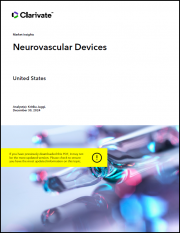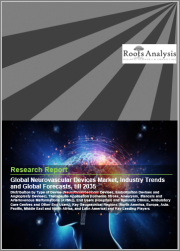
|
시장보고서
상품코드
1609719
일본의 신경혈관 기기 시장 보고서 : 제품, 용도, 최종 사용자 및 지역별(2024-2032년)Japan Neurovascular Devices Market Report by Product, Application (Ischemic Stroke, Aneurysm, Arteriovenous Malformation and Fistulas, Stenosis, and Others), End User, and Region 2024-2032 |
||||||
일본의 신경혈관 기기 시장 규모는 2023년 1억 7,110만 달러로 추정됩니다. 향후 IMARC Group은 2032년까지 시장 규모가 3억 1,860만 달러에 달하고, 2024년부터 2032년까지 7.4%의 연평균 성장률(CAGR)을 나타낼 것으로 예측했습니다. 기술 발전, 신경혈관 질환의 유병률 증가, 덜 침습적인 치료를 선호하는 고령화 등이 시장을 이끄는 주요 요인입니다.
본 보고서에서 다룬 주요 질문
- 일본의 신경혈관 기기 시장은 지금까지 어떻게 성장해왔고, 앞으로 어떻게 발전할 것인가?
- COVID-19가 일본 신경혈관 기기 시장에 미치는 영향은?
- 일본의 신경혈관 기기 시장 제품별 시장 현황은?
- 일본 신경혈관 기기 시장의 용도별 시장 현황은?
- 일본 신경혈관 기기 시장의 최종사용자별 시장 현황은?
- 일본 신경혈관 기기 시장의 가치사슬에는 어떤 단계가 있는가?
- 일본 신경혈관 기기 시장의 주요 촉진요인과 과제는 무엇일까?
- 일본 신경혈관 기기 시장의 구조와 주요 기업은?
- 일본의 신경혈관 기기 시장에서의 경쟁은 어느 정도인가?
목차
제1장 서문
제2장 조사 범위와 조사 방법
- 조사 목적
- 이해관계자
- 데이터 소스
- 시장 추정
- 조사 방법
제3장 주요 요약
제4장 일본의 신경혈관 기기 시장 : 서론
- 개요
- 시장 역학
- 업계 동향
- 경쟁 정보
제5장 일본의 신경혈관 기기 시장 구도
- 과거 및 현재 시장 동향(2018-2023년)
- 시장 예측(2024-2032년)
제6장 일본의 신경혈관 기기 시장 : 제품별 분석
- 뇌 색전술 및 동맥류 코일 색전 디바이스
- 뇌혈관 성형술 및 스텐트 유치 시스템
- 신경 혈전 제거 디바이스
- 지원 디바이스
제7장 일본의 신경혈관 기기 시장 : 용도별 분석
- 허혈성 뇌졸중
- 동맥류
- 동정맥기형 및 누공(AVM)
- 협착
- 기타
제8장 일본의 신경혈관 기기 시장 : 최종사용자별 분석
- 병원
- 외래수술센터(ASC)
- 클리닉
- 기타
제9장 일본의 신경혈관 기기 시장 : 경쟁 구도
- 개요
- 시장 구조
- 시장 기업 포지셔닝
- 주요 성공 전략
- 경쟁 대시보드
- 기업 평가 상한
제10장 주요 기업 개요
제11장 일본의 신경혈관 기기 시장 : 업계 분석
- 성장 촉진요인 및 억제요인과 기회
- Porter의 Five Forces 분석
- 밸류체인 분석
제12장 부록
LSH 24.12.23Japan neurovascular devices market size reached US$ 171.1 Million in 2023. Looking forward, IMARC Group expects the market to reach US$ 318.6 Million by 2032, exhibiting a growth rate (CAGR) of 7.4% during 2024-2032. Technological progress, a growing incidence of neurovascular conditions, and an aging population that favors less invasive treatments represent some of the key factors driving the market.
Neurovascular devices are medical instruments specifically designed for the diagnosis and treatment of disorders affecting the blood vessels and nervous system within the brain and spinal cord. They are meticulously manufactured using advanced materials and precision engineering methods to ensure their safety and effectiveness. These devices offer substantial benefits by facilitating minimally invasive procedures, thereby reducing patient discomfort, hospitalization durations, and complications. Neurovascular devices have a wide range of applications in addressing various conditions, including aneurysms, arteriovenous malformations, and ischemic strokes. The categories of neurovascular devices encompass stents, embolic coils, flow diverters, and catheters. Stents provide support to maintain blood vessel integrity, while embolic coils assist in blocking blood flow to treat aneurysms. Flow diverters are employed to redirect blood flow away from weakened vessel areas, and catheters enable the targeted delivery of treatments to affected regions.
Japan Neurovascular Devices Market Trends:
The Japan market for neurovascular devices is significantly influenced by the rising incidence of neurovascular disorders, particularly among the elderly population. As life expectancy continues to increase, so does the prevalence of conditions like ischemic strokes and cerebral aneurysms, necessitating advanced medical interventions. Concurrently, technological advancements in neurovascular devices are reshaping the landscape of interventional neurology. Innovations such as flow-diverting stents and detachable coils are augmenting the effectiveness and safety of neurovascular procedures, garnering interest from healthcare providers and patients alike. Furthermore, the growing recognition of the importance of early diagnosis and treatment for neurovascular disorders is driving market expansion. Besides this, public health campaigns and initiatives centered on stroke awareness and the benefits of timely intervention are boosting patient referrals and treatment rates. Additionally, favorable reimbursement policies and the development of healthcare infrastructure in emerging markets are widening access to neurovascular interventions, propelling market growth on a wide scale. Other factors, including extensive research and development (R&D) efforts undertaken by key industry players and an increasing level of awareness among the general populace, are anticipated to propel the regional market in the coming years.
Japan Neurovascular Devices Market Segmentation:
Product Insights:
- Cerebral Embolization and Aneurysm Coiling Devices
- Embolic Coils
- Flow Diverters
- Liquid Embolic Agents
- Cerebral Angioplasty and Stenting Systems
- Carotid Artery Stents
- Embolic Protection Devices
- Neurothrombectomy Devices
- Clot Retrieval Devices
- Suction Devices
- Vascular Snares
- Support Devices
- Micro Catheters
- Micro Guidewires
Application Insights:
- Ischemic Stroke
- Aneurysm
- Arteriovenous Malformation and Fistulas (AVM)
- Stenosis
- Others
End User Insights:
- Hospitals
- Ambulatory Surgical Centers
- Clinics
- Others
Competitive Landscape:
The market research report has also provided a comprehensive analysis of the competitive landscape. Competitive analysis such as market structure, key player positioning, top winning strategies, competitive dashboard, and company evaluation quadrant has been covered in the report. Also, detailed profiles of all major companies have been provided.
Key Questions Answered in This Report:
- How has the Japan neurovascular devices market performed so far and how will it perform in the coming years?
- What has been the impact of COVID-19 on the Japan neurovascular devices market?
- What is the breakup of the Japan neurovascular devices market on the basis of product?
- What is the breakup of the Japan neurovascular devices market on the basis of application?
- What is the breakup of the Japan neurovascular devices market on the basis of end user?
- What are the various stages in the value chain of the Japan neurovascular devices market?
- What are the key driving factors and challenges in the Japan neurovascular devices?
- What is the structure of the Japan neurovascular devices market and who are the key players?
- What is the degree of competition in the Japan neurovascular devices market?
Table of Contents
1 Preface
2 Scope and Methodology
- 2.1 Objectives of the Study
- 2.2 Stakeholders
- 2.3 Data Sources
- 2.3.1 Primary Sources
- 2.3.2 Secondary Sources
- 2.4 Market Estimation
- 2.4.1 Bottom-Up Approach
- 2.4.2 Top-Down Approach
- 2.5 Forecasting Methodology
3 Executive Summary
4 Japan Neurovascular Devices Market - Introduction
- 4.1 Overview
- 4.2 Market Dynamics
- 4.3 Industry Trends
- 4.4 Competitive Intelligence
5 Japan Neurovascular Devices Market Landscape
- 5.1 Historical and Current Market Trends (2018-2023)
- 5.2 Market Forecast (2024-2032)
6 Japan Neurovascular Devices Market - Breakup by Product
- 6.1 Cerebral Embolization and Aneurysm Coiling Devices
- 6.1.1 Overview
- 6.1.2 Historical and Current Market Trends (2018-2023)
- 6.1.3 Market Segmentation
- 6.1.3.1 Embolic Coils
- 6.1.3.2 Flow Diverters
- 6.1.3.3 Liquid Embolic Agents
- 6.1.4 Market Forecast (2024-2032)
- 6.2 Cerebral Angioplasty and Stenting Systems
- 6.2.1 Overview
- 6.2.2 Historical and Current Market Trends (2018-2023)
- 6.2.3 Market Segmentation
- 6.2.3.1 Carotid Artery Stents
- 6.2.3.2 Embolic Protection Devices
- 6.2.4 Market Forecast (2024-2032)
- 6.3 Neurothrombectomy Devices
- 6.3.1 Overview
- 6.3.2 Historical and Current Market Trends (2018-2023)
- 6.3.3 Market Segmentation
- 6.3.3.1 Clot Retrieval Devices
- 6.3.3.2 Suction Devices
- 6.3.3.3 Vascular Snares
- 6.3.4 Market Forecast (2024-2032)
- 6.4 Support Devices
- 6.4.1 Overview
- 6.4.2 Historical and Current Market Trends (2018-2023)
- 6.4.3 Market Segmentation
- 6.4.3.1 Micro Catheters
- 6.4.3.2 Micro Guidewires
- 6.4.4 Market Forecast (2024-2032)
7 Japan Neurovascular Devices Market - Breakup by Application
- 7.1 Ischemic Stroke
- 7.1.1 Overview
- 7.1.2 Historical and Current Market Trends (2018-2023)
- 7.1.3 Market Forecast (2024-2032)
- 7.2 Aneurysm
- 7.2.1 Overview
- 7.2.2 Historical and Current Market Trends (2018-2023)
- 7.2.3 Market Forecast (2024-2032)
- 7.3 Arteriovenous Malformation and Fistulas (AVM)
- 7.3.1 Overview
- 7.3.2 Historical and Current Market Trends (2018-2023)
- 7.3.3 Market Forecast (2024-2032)
- 7.4 Stenosis
- 7.4.1 Overview
- 7.4.2 Historical and Current Market Trends (2018-2023)
- 7.4.3 Market Forecast (2024-2032)
- 7.5 Others
- 7.5.1 Historical and Current Market Trends (2018-2023)
- 7.5.2 Market Forecast (2024-2032)
8 Japan Neurovascular Devices Market - Breakup by End User
- 8.1 Hospitals
- 8.1.1 Overview
- 8.1.2 Historical and Current Market Trends (2018-2023)
- 8.1.3 Market Forecast (2024-2032)
- 8.2 Ambulatory Surgical Centers
- 8.2.1 Overview
- 8.2.2 Historical and Current Market Trends (2018-2023)
- 8.2.3 Market Forecast (2024-2032)
- 8.3 Clinics
- 8.3.1 Overview
- 8.3.2 Historical and Current Market Trends (2018-2023)
- 8.3.3 Market Forecast (2024-2032)
- 8.4 Others
- 8.4.1 Historical and Current Market Trends (2018-2023)
- 8.4.2 Market Forecast (2024-2032)
9 Japan Neurovascular Devices Market - Competitive Landscape
- 9.1 Overview
- 9.2 Market Structure
- 9.3 Market Player Positioning
- 9.4 Top Winning Strategies
- 9.5 Competitive Dashboard
- 9.6 Company Evaluation Quadrant
10 Profiles of Key Players
- 10.1 Company A
- 10.1.1 Business Overview
- 10.1.2 Product Portfolio
- 10.1.3 Business Strategies
- 10.1.4 SWOT Analysis
- 10.1.5 Major News and Events
- 10.2 Company B
- 10.2.1 Business Overview
- 10.2.2 Product Portfolio
- 10.2.3 Business Strategies
- 10.2.4 SWOT Analysis
- 10.2.5 Major News and Events
- 10.3 Company C
- 10.3.1 Business Overview
- 10.3.2 Product Portfolio
- 10.3.3 Business Strategies
- 10.3.4 SWOT Analysis
- 10.3.5 Major News and Events
- 10.4 Company D
- 10.4.1 Business Overview
- 10.4.2 Product Portfolio
- 10.4.3 Business Strategies
- 10.4.4 SWOT Analysis
- 10.4.5 Major News and Events
- 10.5 Company E
- 10.5.1 Business Overview
- 10.5.2 Product Portfolio
- 10.5.3 Business Strategies
- 10.5.4 SWOT Analysis
- 10.5.5 Major News and Events
11 Japan Neurovascular Devices Market - Industry Analysis
- 11.1 Drivers, Restraints, and Opportunities
- 11.1.1 Overview
- 11.1.2 Drivers
- 11.1.3 Restraints
- 11.1.4 Opportunities
- 11.2 Porters Five Forces Analysis
- 11.2.1 Overview
- 11.2.2 Bargaining Power of Buyers
- 11.2.3 Bargaining Power of Suppliers
- 11.2.4 Degree of Competition
- 11.2.5 Threat of New Entrants
- 11.2.6 Threat of Substitutes
- 11.3 Value Chain Analysis



















